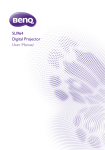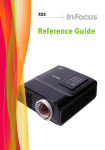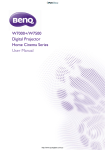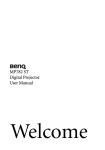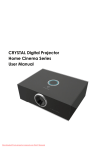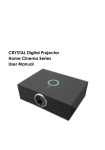Download SH940 Digital Projector User Manual
Transcript
SH940 Digital Projector User Manual English Table of contents Important safety instructions ............................3 Overview................................6 Shipping contents...................................... 6 Remote control batteries ....................... 7 Remote control operation ..................... 7 Projector features .................................... 8 Projector exterior view .......................... 9 Controls and functions..........................10 Control panel ............................................... 10 Remote control............................................ 11 Positioning your projector.12 Choosing a location ...............................12 Obtaining a preferred projected image size .............................................................13 Using the preset and user modes ...... 27 Fine-tuning the picture quality ............ 29 Advanced picture quality controls ..... 30 Selecting the aspect ratio ..................... 33 Hiding the image..................................... 35 Freezing the image................................. 35 Adjusting the sound............................... 36 Controlling the projector through a Lan environment............................................ 37 Operating in a high altitude environment............................................ 39 Displaying more than one image source simultaneously ........................................ 40 Turning the projector off..................... 41 On-Screen Display (OSD) menus ...... 42 Additional information ...... 51 Projection dimensions ................................ 14 Shifting the projection lens........................ 16 Care of the projector ........................... 51 Lamp information................................... 52 Connecting with video equipment ...........................17 Getting to know the lamp hour................52 Extending lamp life .......................................52 Timing of replacing the lamp .....................53 Replacing the lamp .......................................53 Preparations.................................................. 17 Connecting HDMI devices......................... 17 Connecting component-video/RGB devices............................................................ 18 Connecting video devices .......................... 18 Connecting a computer ............................. 19 Connecting a monitor ................................ 19 Using the projector ............20 Turning the projector on .....................20 Selecting an input source......................21 Using the menus .....................................22 Securing the projector ..........................22 Using a security cable lock ........................ 22 Utilizing the password function................ 23 Adjusting the projected image.............25 Adjusting the projection angle ................. 25 Auto-adjusting the image ........................... 25 Fine-tuning the image size and clarity ..... 25 Correcting picture distortion ................... 26 2 Table of contents Indicators ................................................. 56 Troubleshooting..................................... 57 Specifications........................................... 58 Warranty and Copyright information ......................... 62 Important safety instructions Your projector is designed and tested to meet the latest standards for safety of information technology equipment. However, to ensure safe use of this product, it is important that you follow the instructions mentioned in this manual and marked on the product. 1. Please read this user manual before you operate your projector. Keep this manual in a safe place for future reference. 2. Always place the projector on a level, horizontal surface during operation. 4. Do not place the projector in any of the following environments: - space that is poorly ventilated or confined. Allow at least 50 cm clearance from walls and free flow of air around the projector; - locations where temperatures may become excessively high, such as the inside of a car with all windows closed; - locations where excessive humidity, dust, or cigarette smoke may contaminate optical components, shorten the projector’s lifespan and darken the screen; - Do not place the projector on an unstable cart, stand, or table as it may fall and be damaged; - Do not place inflammables near the projector; - Do not use if tilted at an angle of more than 10 degrees left to right, nor at angle of more than 15 degrees front to back. 3. Do not store the projector on end vertically. Doing so may cause the projector to fall over, causing injury or resulting in damage. - locations near fire alarms; - locations with an ambient temperature above 35°C/95°F; - locations where altitude is higher than 1500 meters/4920 feet above sea level. 49209840 feet Important safety instructions 3 English Thank you for your purchase of this quality BenQ projector! It has been designed to provide you with an enjoyable home theater viewing experience. For the best results, please read this manual through carefully as it is your guide through the control menus and operation. English 5. Do not block the vents holes while the projector 9. Do not look straight into the projector lens is on (even in standby mode): during operation. It may harm your sight. - Do not cover the projector with any item; - Do not place the projector on a blanket, bedding or any other soft surface. 10. Do not operate the projector lamp beyond the 6. In areas where the mains power supply voltage rated lamp life. Excessive operation of lamps may fluctuate by ±10 volts, it is recommended that you connect your projector through a power beyond the rated life could cause a lamp to break stabilizer, surge protector or uninterruptible on rare occasions. power supply (UPS) as appropriate to your situation. 7. Do not step on the projector or place any objects 11. The lamp becomes extremely hot during upon it. operation. Allow the projector to cool for approximately 45 minutes prior to removing the lamp assembly for replacement. 8. Do not place liquids near or on the projector. 12. This projector is capable of displaying inverted Liquids spilled into the projector will void your images for ceiling mount installation. Use only BenQ's Ceiling Mount Kit for mounting. warranty. If the projector does become wet, disconnect it from the power point and call BenQ to have the projector repaired. 4 Important safety instructions English 13. Never attempt to replace the lamp assembly until Moisture condensation the projector has cooled down and is unplugged Never operate the projector immediately after from the power supply. moving it from a cold location to a hot location. When the projector is exposed to such a change in temperature, moisture may condense on the crucial internal parts. To prevent the projector from possible damage, do not use the projector for at least 2 hours when there is a sudden change in temperature. 14. When you think service or repair is required, take the projector only to a suitably qualified technician. Avoid volatile liquids Do not use volatile liquids, such as insecticide or certain types of cleaner, near the projector. Do not have rubber or plastic products touching the projector for a long time. They will leave marks on the finish. If cleaning with a chemically treated cloth, be sure to follow the cleaning product’s safety instructions. Disposal 15. Do not attempt to disassemble this projector. There are dangerous high voltages inside which may cause death if you should come into contact with live parts. The only user serviceable part is the lamp which has its own removable cover. See page 53. Under no circumstances should you ever undo or remove any other covers. Refer servicing only to suitably qualified professional service personnel. This product contains the following materials which are harmful to human bodies and environment. • Lead, which is contained in solder. • Mercury, which is used in the lamp. To dispose of the product or used lamps, consult your local environment authorities for regulations. Notice Please keep the original packing for possible future shipment. If you need to pack your projector after use, adjust the projection lens to an appropriate position, put the lens cushion around the lens, and fit the lens cushion and projector cushion together to prevent damage during transportation. Important safety instructions 5 English Overview Shipping contents Carefully unpack and verify that you have the items below. Some of the items may not be available depending on your region of purchase. Please check with your place of purchase. Some of the accessories may vary from region to region. The warranty card is only supplied in some specific regions. Please consult your dealer for detailed information. Projector Remote control Batteries VGA cable Digital Quick Projector Start Guide Warranty card 6 Overview User manual CD Quick start guide Power cable 1. To open the battery cover, turn the remote control over to view its back, push on the finger grip on the cover and slide it down in the direction of the arrow as illustrated. The cover will slide off. 2. Remove any existing batteries (if necessary) and install two new AAA batteries observing the battery polarities as indicated in the base of the battery compartment. Positive (+) goes to positive and negative (-) goes to negative. 3. Refit the cover by aligning it with the case and sliding it back up into position. Stop when it clicks into place. Notes on handling batteries • Do not mix old batteries with new ones, or mix different types of batteries. • Avoid leaving the remote control and batteries in an excessive hot or humid environment like the kitchen, bathroom, sauna, sunroom, or in a closed car. • Dispose of used batteries according to the battery manufacturer’s instructions and local environment regulations for your region. • If the remote control will not be used for an extended period of time, remove the batteries to avoid damage to the control from possible battery leakage. Remote control operation • • Make sure that there is nothing positioned between the remote control and the infrared (IR) sensors on the projector that might obstruct the IR beam from the remote control reaching the projector. up to 8 m The effective range of the remote control is up to 8 meters, and at an angle within 30 degrees of the IR beam. Always aim straight at the projector, however most screens will also reflect the IR beam to the projector. Ceiling mounting the projector We want you to have a pleasant experience using your BenQ projector, so we need to bring this safety matter to your attention to prevent damage to person and property. If you intend to mount your projector on the ceiling, we strongly recommend that you use a proper fitting BenQ projector ceiling mount kit and that you ensure it is securely and safely installed. If you use a non-BenQ brand projector ceiling mount kit, there is a safety risk that the projector may fall from the ceiling due to an improper attachment through the use of the wrong gauge or length screws. You can purchase a BenQ projector ceiling mount kit from the place you purchased your BenQ projector. BenQ recommends that you also purchase a separate Kensington lock compatible security cable and attach it securely to both the Kensington lock slot on the projector and the base of the ceiling mount bracket. This will perform the secondary role of restraining the projector should its attachment to the mounting bracket become loose. Overview 7 English Remote control batteries English Projector features • • • • • • • • • • 8 Full HD compatible The projector is compatible with Standard Definition TV (SDTV) 480i, 480p, 576i, 576p, and High Definition TV (HDTV) 720p, 1080i and 1080p formats, with the 1080p format providing a true 1:1 image reproduction. High picture quality The projector provides excellent picture quality due to its high resolution, excellent home theater brightness, super high contrast ratio, vivid color and rich gray-scale reproduction. High brightness The projector features super high brightness to achieve excellent picture quality in ambient light conditions, outperforming ordinary projectors. Super-high contrast ratio The projector features a dynamic black control to achieve a super-high contrast ratio. Vivid color reproduction The projector features a 6-segment color wheel to produce realistic color depth and range unattainable with lesser segment color wheels. Rich gray-scale When viewed in a darkened environment, the automatic gamma control provides excellent gray-scale display which reveals details in shadows and in night or darkened scenes. Intuitive lens shift The intuitive control over lens shift lever provides flexibility in setting-up your projector. Wide variety of inputs and video formats The projector supports a wide variety of inputs for connection to your video and PC equipment, including component video, and composite video, as well as HDMI, PC, and an output trigger for connection to automated screen and environment lighting systems. Professional calibration control To reach a higher standard of performance, the projector incorporates Expert Mode settings in its OSD menus, which requires professional calibration service from authorized installers. Panamorph lenses compatible The projector is compatible with Panamorph lenses that allow you to convert 16:9 projectors to 2.35:1 aspect ratio. Overview English Projector exterior view Front and upper side view 1. Control panel (See "Control panel" on page 10 for details.) 1 2. Lamp cover 2 3 3. Front IR sensor 4 4. Lens shift lever 5. Projection lens 5 6. Vent (heated air exhaust) 7. AC Power cable inlet 8. Rear IR sensor 6 9. RJ45 LAN input jack 10. HDMI port 11. Composite Video input (RCA) Rear view 12. USB port See "Connecting with video equipment" on 13. RS-232 control port page 17 for connection details. Used to interface with a PC or home theater control/automation system. 14. 12VDC output terminal 7 8 9 10 11 12 13 14 15 16 17 Used to trigger external devices such as an electric screen or light control, etc. Consult your dealer for how to connect these devices. 15. Component Video inputs (BNC)/RGBHV 5 BNCs for connecting either RGB or component (YPbPr), SD or HD video signals. 18 16. RGB (PC)/Component video (YPbPr/ YCbCr) signal input jack Under view RGB signal output jack 17. Audio input jack Audio output jack 19 18. Kensington lock slot 19. Adjustable feet 20. Ceiling mount holes 20 20 19 Overview 9 English Controls and functions Control panel 6. Arrow/Keystone keys (Left / , Up / , Right / , Down / ) Moves the current On-Screen Display (OSD) menu selection in the direction of the arrow being pressed when the OSD menu is activated. 1 2 3 4 Manually corrects distorted pictures resulting from an angled projection. 5 6 7 6 8 6 9 7. 10 6 11 12 1. Focus ring Adjusts the focus of the projected image. 2. Zoom ring Adjusts the size of the projected image. 3. LAMP indicator light Lights up or flashes when the projector lamp has developed a problem. 4. TEMPerature warning light Lights up or flashes if the projector's temperature becomes too high. 5. POWER indicator light Lights up or flashes when the projector is operating. 10 Overview POWER Performs the same action as POWER on the remote control. I I Toggles the projector between standby and on. 8. SOURCE Performs the same action as the source selection keys on the remote control. Switches sequentially through input sources. 9. MENU Toggles the On-Screen Display (OSD) menu on and off. 10. PRESET MODE Sequentially selects a predefined picture setting available for each input. 11. EXIT Goes back to previous OSD menus, exits and saves any changes made using the On-Screen Display (OSD) menu. 12. ENTER Enacts the selected On-Screen Display (OSD) menu item. Remote control 1 9. FREEZE Freezes the projected image. 2 3 4 5 6 7 8 9 10 11 English 8. TEST Displays the test pattern. 13 10. PIP Displays the Picture In Picture (PIP) windows. 14 11. NETWORK SETTING Enters network settings directly. 15 12. Numeric buttons Enters numbers in network settings. 16 17 18 19 20 12 Numeric buttons 1, 2, 3, 4 cannot be pressed when asked to enter password. 13. AUTO Automatically determines the best picture timings for the displayed image. 14. SOURCE Selects an input source for display. 15. VOLUME+/VOLUMEAdjusts the sound level. 1. Power ON/OFF Toggles the projector between standby mode and on. I I 2. Source selection keys Selects an input source for display. 3. MENU/EXIT Turns on the On-Screen Display (OSD) menu. Goes back to previous OSD menu, exits and saves menu settings. 16. BRIGHTNESS Adjusts brightness. 17. CONTRAST Adjusts contrast. 18. MUTE Toggles projector audio between on and off. 19. ASPECT Selects the display aspect ratio. 20. LAMP MODE Selects a preferred lamp mode. 4. Arrow/Keystone keys (Left / , Up / , Right / , Down / ) Operating the LASER pointer Moves the current On-Screen Display (OSD) The Laser Pointer is a presentation menu selection in the direction of the arrow being pressed when the OSD menu is activated. aid for professionals. It emits red colored light when you press it and Manually corrects distorted pictures resulting the indicator lights up red. from an angled projection. The laser pointer is not a toy. 5. MODE/ENTER Activates the selected On-Screen Display (OSD) Parents should be mindful of the dangers of laser energy and keep this menu item. remote control out of the reach of children. Depending upon the input signal in use, selects an available picture mode. Do not look into the laser light window or shine 6. ECO BLANK Used to hide the screen image. 7. LASER Emits visible laser pointer light for presentation purposes. the laser light beam on yourself or others. See the warning messages on the back of the remote control prior to using it. Overview 11 English Positioning your projector Choosing a location Your projector is designed to be installed in one of four possible installation locations. Your room layout or personal preference will dictate which installation location you select. Take into consideration the size and position of your screen, the location of a suitable power outlet, as well as the location and distance between the projector and the rest of your equipment. 1. Floor Front: 3. Floor Rear: Select this location with the projector placed near Select this location with the projector placed near the floor in front of the screen. This is the most the floor behind the screen. common way to position the projector for quick Note that a special rear projection screen is setup and portability. required. *Set Floor Rear after you turn the projector on. 2. Ceiling Front: 4. Ceiling Rear: Select this location with the projector suspended from the ceiling in front of the screen. Select this location with the projector suspended from the ceiling behind the screen. Purchase the BenQ Projector Ceiling Mount Kit from your dealer to mount your projector on the ceiling. Note that a special rear projection screen and the BenQ Projector Ceiling Mount Kit are required for this installation location. *Set Ceiling Front after you turn the projector on. *Set Ceiling Rear after you turn the projector on. *To set the projector position: 12 1. Press MENU on the projector or MENU/EXIT on the remote control and then press is highlighted. 2. Press / to highlight Projector Position and press Positioning your projector / / until the System Setup menu until the correct position is selected. The distance from the projector lens to the screen, the zoom setting, and the video format each factors in the projected image size. This projector is equipped with a movable lens. See "Shifting the projection lens" on page 16 for details. You can see the diagrams on pages 14 and 15 for the vertical offset values in the dimension tables that are measured when the lens is shifted fully up or down. If you are using a 120-inch, 4:3-aspect-ratio screen, please refer to "The screen aspect ratio is 4:3 and the projected picture is 16:9". The average projection distance is 494 cm. If you have a 16:9-aspect-ratio screen and your measured projection distance was 4.5 m (450 cm), please refer to "The screen aspect ratio is 16:9 and the projected picture is 16:9". The closest match in the "Average" column is 449 cm. Looking across this row shows that a 100-inch screen is required. Checking the min and max projection distance values in the columns of "Projection distance <D> [cm]" on page 14 indicates that the 4.5 m measured projection distance will also fit the 90 and 110-inch size screens. The projector can be adjusted (using the zoom control) to display on these different screen sizes at the projection distance. Be aware that these different screens have different vertical offset values. If you place the projector in a different position (to that recommended), you will have to tilt it down or up to center the image on the screen. In these situations, some image distortion will occur. Use the Keystone function to correct the distortion. See "Correcting picture distortion" on page 26 for details. Positioning your projector 13 English Obtaining a preferred projected image size Projection dimensions English Installation for a 16:9 ratio screen Ceiling Installation Floor Installation <B> <A> <F> <A> <G> <C> <D> <E> <B> <E> <G> <D> <F>: Screen <F> <C> <F>: Screen <G>: Center of lens <G>: Center of lens The screen aspect ratio is 16:9 and the projected picture is 16:9 Screen dimensions Diagonal <A> [inch (mm)] Height <B> [cm] Projection distance <D> [cm] Width <C> [cm] Min distance (with max zoom) Average Max distance (with min zoom) Lowest/Highest lens position <E> [cm] 30 (762) 37 66 108 135 162 4.7 40 (1016) 50 89 144 180 215 6 50 (1270) 62 111 180 224 269 8 60 (1524) 75 133 215 269 323 9 70 (1778) 87 155 251 314 377 11 80 (2032) 100 177 287 359 431 12 90 (2286) 112 199 323 404 485 14 100 (2540) 125 221 359 449 539 16 110 (2794) 137 243 395 494 592 17 120 (3048) 149 266 431 539 646 19 130 (3302) 162 288 467 583 700 20 140 (3556) 174 310 503 628 754 22 150 (3810) 187 332 539 673 808 23 160 (4064) 199 354 575 718 862 25 170 (4318) 212 376 610 763 916 26 180 (4572) 224 398 646 808 969 28 190 (4826) 237 421 682 853 1023 30 200 (5080) 249 443 718 898 1077 31 250 (6350) 311 553 898 1122 1346 39 300 (7620) 374 664 1077 1346 1616 47 The above numbers are approximate and may be slightly different from the actual measurements. Only the recommended screen sizes are listed. If your screen size is not in the table above, please contact your dealer for assistance. 14 Positioning your projector Installation for a 4:3 ratio screen Floor Installation <A> <H> Ceiling Installation <A> <B> <H> <F> <D> <E> <G> <G> <C> <F>: Screen <E> <F> <D> <B> <C> <G>: Center of lens <F>: Screen <G>: Center of lens The screen aspect ratio is 4:3 and the projected picture is 16:9 Projection distance <D> [cm] Screen dimensions Diagonal Height <A> <B> [inch (mm)] [cm] Width <C> [cm] Min distance (with max zoom) Average Max distance (with min zoom) Lowest/ Highest lens position <E> [cm] Image height <H> [cm] 30 (762) 46 61 99 124 148 4.3 34.3 40 (1016) 61 81 132 165 198 5.7 45.7 50 (1270) 76 102 165 206 247 7.1 57.2 60 (1524) 91 122 198 247 297 8.6 68.6 70 (1778) 107 142 231 288 346 10.0 80.0 80 (2032) 122 163 264 330 395 11.4 91.4 90 (2286) 137 183 297 371 445 12.9 102.9 100 (2540) 152 203 330 412 494 14.3 114.3 110 (2794) 168 224 363 453 544 15.7 125.7 120 (3048) 183 244 395 494 593 17.1 137.2 130 (3302) 198 264 428 536 643 18.6 148.6 140 (3556) 213 284 461 577 692 20.0 160.0 150 (3810) 229 305 494 618 742 21.4 171.5 160 (4064) 244 325 527 659 791 22.9 182.9 170 (4318) 259 345 560 700 840 24.3 194.3 180 (4572) 274 366 593 742 890 25.7 205.7 190 (4826) 290 386 626 783 939 27.1 217.2 200 (5080) 305 406 659 824 989 28.6 228.6 250 (6350) 381 508 824 1030 1236 35.7 285.8 300 (7620) 457 610 989 1236 1483 42.9 342.9 The above numbers are approximate and may be slightly different from the actual measurements. Only the recommended screen sizes are listed. If your screen size is not in the table above, please contact your dealer for assistance. Positioning your projector 15 English The illustrations and table below are provided for those users who already have 4:3 aspect ratio screens or intend to purchase 4:3 aspect ratio screens to view 16:9 ratio projected images. Shifting the projection lens English The lens shift control provides flexibility for installing your projector. It allows the projector to be positioned off the center of the screen. The lens shift is expressed as a percentage of the projected image height or width. It is measured as an offset from the projected image’s vertical or horizontal center. You can use the lever to shift the projection lens in any direction within the allowable range depending on your desired image position. To use the lens shift lever: 1. Release the lever by turning it counterclockwise. 2. Move the lever to adjust the projected image position. 3. Lock the lever by turning it clockwise. • When the screen position is fixed Projector Range of placement Screen Center of lens • When the projector position is fixed 125% 125% 41.3% 16 41.3% • Please do not over-tighten the lever. • Lens shift adjustment will not result in a degraded picture quality. In the unlikely event that the image distortion is produced, see "Adjusting the projected image" on page 25 for details. Positioning your projector English Connecting with video equipment You can connect the projector to any type of video equipment, such as a VCR, DVD player, digital tuner, cable or satellite decoder, video game console or digital camera. You can also connect it to a desktop or laptop PC or Apple Macintosh system. You need only connect the projector to a source device using just one of the connecting methods, however each provides a different level of video quality. The method you choose will most likely depend upon the availability of matching terminals on both the projector and the Video source device as described below: Terminal name Terminal appearance HDMI Component Video Reference "Connecting HDMI devices" on page 17 Best "Connecting component-video/RGB devices" on page 18 Better "Connecting video devices" on page 18 Video "Connecting a computer" on page 19 PC (D-SUB) Picture quality Normal Better PC Preparations When connecting a signal source to the projector, be sure to: 1. Turn off all equipment before making any connections. 2. Use only the correct type cables for each source with proper type plugs. 3. Ensure that all cable plugs are firmly fitted to the equipment jacks. Note that all cables shown in the following connection diagrams may not be supplied with the projector (See "Shipping contents" on page 6 for details). Most cables are commercially available from electronics stores. Connecting HDMI devices HDMI (High-Definition Multimedia Interface) supports uncompressed video data transmission between compatible devices like DTV tuners, DVD players and displays over a single cable. It provides pure digital viewing and listening experience. You should use an HDMI cable when making connection between the projector and HDMI devices. HDMI device: DVD player, digital tuner, etc. To make sure you select a correct input source type for the HDMI signal, see "HDMI Settings" on page 49 for details. HDMI cable Connecting with video equipment 17 Connecting component-video/RGB devices English Connect your RGB source (DVD player or HD set top box) to the RBGHV inputs. You can also use a BNC- type component cable to connect your video devices. The audio connections are provided for informational purposes only. You can also connect the separate audio cable to a suitable audio amplifier. Audio cable AV equipment: DVD player, digital tuner, etc. RGBHV cable Speakers Component video cable Audio cable Connecting video devices You need only connect a composite Video cable from the same device. The audio connections are provided for informational purposes only. You can also connect the separate audio cable to a suitable audio amplifier. AV equipment Audio cable Video cable Speakers Audio cable 18 • If you have already made a Component Video connection between the projector and the video source device, you need not connect to this device again using a composite Video connection as this makes an unnecessary second connection of poorer picture quality. You need only connect using a composite Video connection if Component Video is not supplied on the video source device (for example, with some analog video cameras). • If the selected video image is not displayed after the projector is turned on and the correct video source has been selected, please check that the video source device is turned on and operating correctly. Also check that the signal cables have been connected correctly. Connecting with video equipment Connecting a computer English Connect the projector to a computer with a VGA cable or a DB15HD-to-5 x BNC cable. Audio cable Laptop or desktop computer VGA cable DB15HD-to-5 x BNC cable Speakers Audio cable Many laptops do not turn on their external video ports when connected to a projector. Usually a key combination like Fn + F3 or CRT/LCD key turns the external display on/off. Locate a function key labeled CRT/LCD or a function key with a monitor symbol on the laptop. Press Fn and the labeled function key simultaneously. Refer to your laptop's documentation to discover your laptop's key combination. Connecting a monitor If you want to view your presentation close-up on a monitor as well as on the screen and the MONITOR OUT jack is available on your projector, you can connect the MONITOR OUT signal output jack on the projector. or VGA cable VGA to DVI cable • The MONITOR OUT only works when an appropriate D-Sub input is made to the PC jack. • If you wish to use this connection method when the projector is in standby mode, make sure the Standby Monitor Out function is turned on in the Advanced Setup menu. See "Standby Monitor Out" on page 48 for details. Connecting with video equipment 19 English Using the projector Preparations 1. Plug in and turn all of the connected equipment on. 2. If not already in, plug the supplied power cable into the AC inlet on the rear of the projector. 3. Plug the power cable into a wall power outlet and turn the wall switch on. Please use the original accessories (e.g. power cable) only with the device to avoid possible dangers such as electric shock and fire. Turning the projector on Follow the steps below. 1. Make sure the Power light is orange after power has been applied. 2. Press and hold POWER ( II ) on the projector or ON on the remote control to turn the projector on. As soon as the lamp lights up, a "Power On Ring Tone" will be heard. To turn of the ring tone, see "Turning off the Power On/Off Ring Tone" on page 36 for details. 3. The fans will start operating, and a start-up image will be displayed on the screen for a few seconds while it warms up. The projector will not respond to further commands while it is warming up. 4. If the projector is activated for the first time, select your OSD language following the on-screen instructions. 5. If you are prompted for a password, press the arrow keys to enter a six-digit password. See "Utilizing the password function" on page 23 for details. 6. Press one of the Source keys on the remote control, or press SOURCE on the projector repeatedly until your desired signal is selected. See "Selecting an input source" on page 21 for details. 7. If the horizontal frequency of the input source exceeds the range of the projector, the message "No Signal" will be displayed on the screen. This message will remain on-screen until you change the input source to an appropriate one. If you attempt to re-start the projector shortly after shutdown, the fans may run for a few minutes to cool down. Press II Power again to start the projector after the fans stop and the Power indicator light turns orange. 20 Using the projector English Selecting an input source The projector can be connected to multiple equipment at the same time. When the projector is first turned on, it will attempt to reconnect with the input source which was in use when the projector was last shut down. To select the video source: • Using the remote control or projector Press one of the Source keys on the remote control, or press SOURCE on the projector repeatedly until your desired signal is selected. • Using the OSD menu 1. Press MENU on the projector or MENU/EXIT on the remote control, and then press / until the System Setup menu is highlighted. NOTE: When 2. Press to highlight Input Source and press ENTER. The automatically searching for a valid source selection bar is displayed. input source, the 3. Press / repeatedly until your desired signal is selected and projector cycles through the available press ENTER. signals following the Once detected, the selected source information will be displayed sequence from top to bottom as the source on the screen for seconds. If there are multiple pieces of selection bar shows. equipment connected to the projector, you can go back to the source selection bar again to search for other signals. • If you want the projector to automatically search for the signals, select On in the System Setup > Auto Source Search menu. • If you want to use the PIP function, see "Displaying more than one image source simultaneously" on page 40 for details. HDMI 1 HDMI 2 Video Component 1 Component 2 Computer 1 Computer 2 Changing Color Space In the unlikely event that you connect the projector to a DVD player via the projector's HDMI input and the projected picture displays wrong colors, please change the color space to YUV. 1. Press MENU/EXIT and then press / until the Display menu is highlighted. 2. Press to highlight Color Space Conversion and press / to select a suitable color space. This function is only available when the HDMI input port is in use. Using the projector 21 English Using the menus The projector is equipped with multilingual On-Screen Display (OSD) menus for making various adjustments and settings. Below is the overview of the OSD menu. Main menu icon Main menu Picture -- Basic Picture Mode Highlight Cinema Load Settings From Sub-menu Brightness + 50 Contrast + 50 Color + 50 Status 0 Tint Sharpness +3 Reset Picture Settings Press EXIT to go back to the previous page or to exit. Rename User Mode Current input source EXIT Video Back To use the OSD menus, please set the OSD menu to your familiar language. 1. Press MENU on the projector or MENU/EXIT on the remote control to turn the OSD menu on. Picture -- Basic Picture Mode Load Settings From Brightness Contrast Color Tint Sharpness Reset Picture Settings Rename User Mode Video 2. Use / System Setup Cinema 0 +3 Input Source Auto Source Search Closed Caption Standby Monitor Out EXIT Back System Setup Splash Screen Projector Position Background Color Menu Settings Operation Settings Input Source Auto Source Search Closed Caption Standby Monitor Out Video Language Splash Screen Projector Position Background Color Menu Settings Operation Settings + 50 + 50 + 50 to highlight the System Setup menu. Language 3. Press to highlight Language and press / to select a preferred language. English BenQ Floor Front Blue Off Off Video English BenQ Floor Front Blue Off Off EXIT Back 4. Press MENU once or EXIT twice* on the projector or MENU/EXIT twice* on the remote control to leave and save the settings. *The first press leads you back to the main menu and the second press closes the OSD menu. EXIT Back Securing the projector Using a security cable lock The projector has to be installed in a safe place to prevent theft. Otherwise, purchase a lock, such as the Kensington lock, to secure the projector. You can locate a Kensington lock slot on the projector. See item 18 on page 9 for details. A Kensington security cable lock is usually a combination of key(s) and the lock. Refer to the lock's documentation for finding out how to use it. 22 Using the projector Utilizing the password function You will be inconvenienced if you activate the password functionality and subsequently forget the password. Print out this manual (if necessary) and write the password you used in this manual, and keep the manual in a safe place for later recall. Setting a password Once a password has been set and activated, the projector cannot be used unless the correct password is entered every time the projector is started. 1. Press MENU on the projector or MENU/EXIT on the remote control and then press the Advanced Setup menu is highlighted. 2. Press to highlight Password and press ENTER. The Password page is displayed. 3. Highlight Password and press / to select On. The Input Input Password Password page is displayed. 4. As the picture indicates, the four arrow keys ( , , , ) respectively represent 4 digits (1, 2, 3, 4). According to the password you desire to set, press the arrow keys on the remote control or projector to enter six digits for the password. If the function is used for the first time, enter the default password (1, 1, 1, 1, 1, 1) of the projector by pressing the arrow key six times. Once the password is set, the OSD menu returns to the Password page. / EXIT until Clear IMPORTANT: The digits being input will be displayed as asterisks on-screen. Write your selected password down here in this manual in advance or right after the password is entered so that it is available to you should you ever forget it. Password: __ __ __ __ __ __ 5. To leave the OSD menu, press MENU on the projector or MENU/EXIT on the remote control. If you forget the password If the password function is activated, you will be asked to enter the six-digit password every time you turn on the projector. If you enter the wrong password, the password error message is displayed lasting for three seconds, and the Input Password page follows. You can retry by entering another six-digit password, or if you did not record the password in this manual, and you absolutely do not remember it, you can use the password recall procedure. See "Entering the password recall procedure" on page 24 for details. If you enter an incorrect password 5 times in succession, the projector will automatically shut down in a short time. Using the projector 23 English For security purposes and to help prevent unauthorized use, the projector includes an option for setting up password security. The password can be set through the On-Screen Display (OSD) menu. Once the password is set and this function is selected, the projector is password-protected. Users who do not know the correct password can not use the projector. Entering the password recall procedure English 1. Make sure the Input Password page is displayed on screen. Press and hold PRESET MODE on the projector or MODE/ENTER on the remote control for 3 seconds. The projector will display a coded number on the screen. 2. Write down the number and turn off your projector. 3. Seek help from the local BenQ service center to decode the number. You may be required to provide proof of purchase documentation to verify that you are an authorized user of the projector. Recall Password Please write down the recall code, and contact your nearest BenQ Customer Center. Recall code: 0212 EXIT Back Changing the password 1. Press MENU on the projector or MENU/EXIT on the remote control and then press / until the Advanced Setup menu is highlighted. 2. Press / to highlight Password and press ENTER. The Password page is displayed. 3. Highlight Change Password and press ENTER. The Input Current Password page is displayed. 4. Enter the old password. • • If the password is correct, the message "Input New Password" is displayed. If the password is incorrect, the password error message is displayed lasting for three seconds, and the message "Input Current Password" is displayed for your retry. You can either press MENU on the projector or MENU/EXIT on the remote control to cancel the change or try another password. 5. Enter a new password. IMPORTANT: The digits being input will be displayed as asterisks on-screen. Write your selected password down here in this manual in advance or right after the password is entered so that it is available to you should you ever forget it. Password: __ __ __ __ __ __ Keep this manual in a safe place. 6. Confirm the new password by re-entering the new password. 7. You have successfully assigned a new password to the projector. Remember to enter the new password next time the projector is started. 8. To leave the OSD menu, press MENU on the projector or MENU/EXIT on the remote control. Disabling the password function To disable password protection, go back to the Advanced Setup > Password > Password menu. Highlight Password and select Off by pressing / . The message "Input Password" is displayed. Enter the current password. • If the password is correct, the OSD menu returns to the Password page with "Off" shown in the row of Password. You will not have to enter the password next time when turning on the projector. • If the password is incorrect, the password error message is displayed lasting for three seconds, and the message "Input Password" is displayed for your retry. You can either press MENU on the projector or MENU/EXIT on the remote control to cancel the change or try another password. Note that though the password function is disabled, you need to keep the old password in hand should you ever need to re-activate the password function by entering the old password. 24 Using the projector English Adjusting the projected image Adjusting the projection angle There are four adjuster feet on the bottom of the projector. These can be used if necessary to change the projection angle. Screw the feet in or out as appropriate to aim and level the projection angle. If the screen and the projector are not perpendicular to each other, the projected image becomes vertical trapezoidal. To correct this problem, see "Correcting picture distortion" on page 26 for details. Auto-adjusting the image In some cases, you may need to optimize the picture quality. To do this, press AUTO on the projector or remote control. Within 3 seconds, the built-in Intelligent Auto Adjustment function will re-adjust the values of Frequency and Clock to provide the best picture quality. The current source information will be displayed in the corner of the screen for 3 seconds. • The screen will be blank while AUTO is functioning. • This function is only available when a PC signal (analog RGB) is selected. Fine-tuning the image size and clarity 1. Adjust the projected picture to the size that you need using the zoom ring. 2. Sharpen the picture by rotating the focus ring. Using the projector 25 Correcting picture distortion English Keystoning occurs when the projector is not perpendicular to the screen and is where the projected picture displays visible as a trapezoid shape like either of the following: • • Two parallel sides (left and right, or top and bottom) but is noticeably wider on either side. No parallel sides. To correct the picture’s shape, you can perform the following steps. 1. Adjust the projection angle. Move the projector to be in front of the center of the screen with the center of the lens level with the screen. 2. If the picture is stilled distorted, or the projector is unable to be positioned as described above, you will need to manually correct the picture. • Using the remote control or projector i. Press one of the Arrow/Keystone keys on the remote control or projector (Left / , Up / , Right / , Down / ) to display the Keystone page. ii. See step iv below for further operation. • Using the OSD menu i. Press MENU on the projector or MENU/EXIT on the remote control, and then press / until the Display menu is highlighted. ii. Press to highlight Keystone and press ENTER. The Keystone page is displayed. iii. Highlight 2D Keystone and press ENTER. The keystone correction page is displayed. iv. Press the key whose keystone icon is opposite to the shape of the projected picture. Continue pressing the same key or press the other keys until you are satisfied with the shape. The values on the lower portion of the page change while pressing. When the values reach their maximum or minimum with repeated key presses, the picture’s shape will stop changing. You will not be able to change the picture further in that direction. Two parallel sides Press / . Press . No parallel sides Press / . 26 Using the projector Press / . / English Using the preset and user modes Selecting a preset mode The projector is preset with several pre-defined picture modes so that you can choose one to suit your operating environment and input source picture type. To select a picture mode that suits your need: • Using the remote control Press PRESET MODE on the projector or MODE/ENTER on the remote control repeatedly until your desired mode is selected. • Using the OSD menu 1. Press MENU on the projector or MENU/EXIT on the remote control and then press / until the Picture -- Basic menu is highlighted. 2. Press to highlight Picture Mode. 3. Press / until your desired mode is selected. These modes consist of preset values suitable for various projection situations as described below: • Cinema: Is appropriate for playing colorful movies, video clips from digital cameras or DVs through the PC input for best viewing in a blackened (little light) environment. • Dynamic: Maximizes the brightness of the projected image. This mode is suitable for environments where extra-high brightness is required, such as using the projector in well lit rooms. • Presentation: Is designed for presentations. The brightness is emphasized in this mode to match PC and notebook coloring. • sRGB: Maximizes the purity of RGB colors to provide true-to-life images regardless of brightness setting. It is most suitable for viewing photos taken with an sRGB compatible and properly calibrated camera, and for viewing PC graphic and drawing applications such as AutoCAD. • User 1/User 2: Recalls the customized settings. See "Setting the User 1/User 2 mode" on page 28 for details. Fine-tuning the selected picture mode The pre-defined picture mode settings can be altered via the available items shown in the Picture -Basic and Picture -- Advanced menus. To fine-tune the picture mode: 1. Press MENU on the projector or MENU/EXIT on the remote control, and then press / until the Picture -- Basic or Picture -- Advanced menu is highlighted. 2. Press to highlight the item you want to adjust and press / to set your desired value. Your selection is automatically stored in the projector and associated with that input source. See "Fine-tuning the picture quality" on page 29 and "Advanced picture quality controls" on page 30 for details. Each time you change the picture mode, the projector also changes the setting to the one which was last set for that particular picture mode on that particular input. If you change the input source, the most recently used picture mode and settings for that input and resolution will be restored. Using the projector 27 Setting the User 1/User 2 mode English There are two user-definable modes if the current available picture modes are not suitable for your need. You can use one of the picture modes (except the selected User mode) as a starting point and customize the settings. 1. In the Picture -- Basic menu, highlight Picture Mode and press mode. 2. Press to highlight Load Settings From. / to select User 1 or User 2 This function is only available when User 1 or User 2 mode is selected up in the Picture Mode submenu item. 3. Press ENTER to display the Load Settings From page. 4. Press to highlight a picture mode that is closest to your need and press ENTER and EXIT. 5. Press to select a sub-menu item to be changed and adjust the value with / . See "Fine-tuning the picture quality" on page 29 and "Advanced picture quality controls" on page 30 for details. 6. When all settings have been done, press MENU on the projector or MENU/EXIT on the remote control to save and leave the settings. Renaming user modes You can change User 1 and User 2 to the names easy to be identified or understood by the users of this projector. The new name can be up to 12 characters including English letters (A-Z, a-z), digits (0-9), and space (_). To rename user modes: 1. In the Picture -- Basic menu, highlight Rename User Mode and press ENTER to display the Rename User Mode page. 2. Press / to highlight the item you want to rename and press ENTER. The first letter will be highlighted by a white box. 3. Press / to select the first character. 4. Press to move along until the new name is set and press ENTER to confirm. 5. Repeat steps 2-4 if you want to change the other names. Resetting the picture mode All of the adjustments you’ve done in the Picture -- Basic and Picture -- Advanced menus can be returned to the factory preset values with a key press on the highlight of Reset. To reset the picture mode to the preset factory values: 1. In the Picture -- Basic menu, highlight Picture Mode and press / to select the picture mode (including User 1 or User 2) you want to reset. 2. Press to highlight Reset Picture Settings and press ENTER. The confirmation message is displayed. 3. Press / to highlight Reset and press ENTER. The picture mode will return to the factory preset settings. 4. Repeat steps 1-3 if you want to reset other picture modes. Do not to be confused with the Reset Picture Settings function here with the Reset All Settings in the Advanced Setup menu. The Reset All Settings function returns most of the settings to the factory preset values system wide. See "Reset All Settings" on page 49 for details. 28 Using the projector No matter what picture mode you have selected, you are able to fine-tune those settings to fit every presentation purpose. Those adjustments will be saved to the preset mode you are at when you exit the OSD menu. Adjusting Brightness Highlight Brightness in the Picture -- Basic menu and adjust the values by pressing / on the projector or remote control. The higher the value, the brighter the picture. And the lower the setting, the darker the picture. Adjust this control so the black areas of the picture appear just as black and that detail in the dark areas is visible. 30 50 30 50 70 Adjusting Contrast Highlight Contrast in the Picture -- Basic menu and adjust the values by pressing / on the projector or remote control. The higher the value, the greater the contrast. Use this to set the peak white level after you have previously adjusted the Brightness setting to suit your selected input and viewing environment. 70 Adjusting Color Highlight Color in the Picture -- Basic menu and adjust the values by pressing or remote control. / on the projector Lower setting produces less saturated colors; setting to the minimum value makes the image black and white. If the setting is too high, colors on the image will be overpowering, which makes the image unrealistic. Adjusting Tint Highlight Tint and adjust the values by pressing / on the projector or remote control. The higher the value, the more reddish the picture becomes. The lower the value, the more greenish the picture becomes. Adjusting Sharpness Highlight Sharpness and adjust the values by pressing on the projector or remote control. / The higher the value, the sharper the picture becomes. The lower the value, the softer the picture becomes. 3 5 7 The Brightness, Contrast functions can also be accessible by pressing BRIGHTNESS, CONTRAST on the remote control to display the adjustment bar and then you can press / to adjust the values. Using the projector 29 English Fine-tuning the picture quality English Advanced picture quality controls There are more advanced functions in the Picture -- Advanced menu to be adjusted to your preference. To save the settings, just press MENU on the projector or MENU/EXIT on the remote control to leave the OSD menu. Setting Black Level Highlight Black Level and press / on the projector or remote control to select 0 IRE or 7.5 IRE. The grayscale video signal is measured in IRE units. In some areas which use NTSC TV standard, the grayscale is measured from 7.5 IRE (black) to 100 IRE (white); however, in other areas where PAL equipment or Japanese NTSC standards are used, the grayscale is measured from 0 IRE (black) to 100 IRE (white). We suggest that you check the input source to see if it is with 0 IRE or 7.5 IRE, then select accordingly. Controlling image clarity You may have static or noisy projected pictures. To achieve better picture clarity: 1. Highlight Clarity Control and press ENTER on the projector or remote control to display the Clarity Control page. 2. Press / to select the item you want to adjust and press / to set the desired value. • • • • Noise Reduction: Reduces electrical image noise caused by different media players. The higher the setting, the less the noise. Detail Enhancement: Sharpens the image. The higher the setting, the more details the image reveals. Luma Transmission (Luminance Transmission Improvement): Enhances picture brightness. The higher the setting, the more distinct the effect. Chroma Transmission (Chroma Transmission Improvement): Reduces color smear. The higher the setting, the more distinct the effect. Selecting a color temperature* Highlight Color Temperature and select a preferred setting by pressing remote control. / on the projector or There are several color temperature settings available. 1. Lamp Native: With the lamp’s original color temperature and higher brightness. This setting is suitable for environments where high brightness is required, such as projecting pictures in well lit rooms. 2. Warm: Makes pictures appear reddish white. 3. Normal: Maintains normal colorings for white. 4. Cool: Makes pictures appear bluish white. 5. User 1/User 2/User 3: Recalls the settings customized in the Color Temperature User_ Fine Tuning menu. See "Setting a preferred color temperature" on page 31 for details. *About color temperatures: There are many different shades that are considered to be "white" for various purposes. One of the common methods of representing white color is known as the “color temperature”. A white color with a low color temperature appears to be reddish white. A white color with a high color temperature appears to have more blue in it. 30 Using the projector Setting a preferred color temperature English To set a preferred color temperature: 1. Highlight Color Temperature and select User 1, User 2, or User 3 by pressing / on the projector or remote control. 2. Press to highlight Color Temperature User_ Fine Tuning and press ENTER. The Color Temperature User_ Fine Tuning page is displayed. The menu name "User_" corresponds with the setting selected in Color Temperature. 3. Press / to highlight the item you want to change and adjust the values by pressing / . • Red Gain/Green Gain/Blue Gain: Adjusts the contrast levels of Red, Green, and Blue. • Red Offset/Green Offset/Blue Offset: Adjusts the brightness levels of Red, Green, and Blue. 4. To save and leave the settings, press MENU on the projector or MENU/EXIT on the remote control. Selecting a Gamma setting Highlight Gamma Selection and select a preferred setting by pressing remote control. / on the projector or Gamma refers to the relationship between input source and picture brightness. • Gamma 1/2/3 Select these values according to your preference. • Gamma 4 Increases the average brightness of the picture. Best for a lit environment, meeting room or family room. • Gamma 5/6 Best for viewing movies in a darkened environment. • Gamma 7/8 Best for viewing movies which are mostly composed of dark scenes. High Brightness Low Contrast 1 Low Brightness High Contrast 2 3 4 5 6 7 8 Adjusting Brilliant Color This feature utilizes a new color-processing algorithm and system level enhancements to enable higher brightness while providing truer, more vibrant colors in picture. When set to "Off", Brilliant Color is disabled. Using the projector 31 Color Management English In most installation situations, color management will not be necessary, such as in classroom, meeting room, or lounge room situations where lights remain on, or where building external windows allow daylight into the room. Only in permanent installations with controlled lighting levels such as boardrooms, lecture theaters, or home theaters, should color management be considered. Color management provides fine color control adjustment to allow for more accurate color reproduction, should you require it. Proper color management can only be achieved under controlled and reproducible viewing conditions. You will need to use a colorimeter (color light meter), and provide a set of suitable source images to measure color reproduction. These tools are not provided with the projector, however, your projector supplier should be able to provide you with suitable guidance, or even an experienced professional installer. The Color Management provides six sets (RGBCMY) of colors to be adjusted to favorite colors. When you select each color, you can independently adjust its color range and saturation according to your preference. To adjust and store the settings: 1. In the Picture -- Advanced menu, highlight Color Management and press ENTER. The Color Management page is displayed. 2. Highlight Primary Color and press / to select a color from among Red, Yellow, Green, Cyan, Blue, and Magenta. 3. Press to highlight Range and press / to select the color range you wish to make adjustment. The bigger the range, the more proportions of its two adjacent colors the color contains. Yellow Green Red Please refer to the illustration to the right for how the colors relate to each other. For example, if you select Red and set its range at 0, only pure red is selected. Increasing its range will include both the red Cyan Magenta color close to yellow and red color close to magenta. Blue Press to highlight Saturation and adjust the color saturation level by pressing / . If you select Red and set its range at 0, only the saturation of the pure red will be affected. Saturation is the amount of that color in a video picture. Lower settings produce less saturated colors; a setting of “0” removes that color from the image entirely. If the saturation is too high, that color will be overpowering and unrealistic. 4. To leave and save the settings, press MENU on the projector or MENU/EXIT on the remote control. Setting Film Mode This feature helps improve picture quality when projecting video image from a film-sourced DVD. 32 Using the projector Setting 3D Comb Filter This function is only available when a Video signal is selected Selecting the aspect ratio The "aspect ratio" is the ratio of the image width to the image height. Digital TV is usually in 16:9 ratio, which is the default for this projector, and most analog TV signals and DVDs are in 4:3 ratio. With the advent of digital signal processing, digital display devices like this projector can dynamically stretch and scale the image output to a different aspect than that of the image input source. Images can be stretched in a linear manner so the whole of the image is stretched equally, or non-linearly, which distorts the image. To change the projected picture ratio (no matter what aspect the source is): • Using the remote control 1. Press ASPECT to show the current setting. 2. Press ASPECT repeatedly to select an aspect ratio to suit the format of the video signal and your display requirements. • Using the OSD menu 1. Press MENU on the projector or MENU/EXIT on the remote control, and then press / until the Display menu is highlighted. 2. Press to highlight Aspect Ratio. 3. Press / to select an aspect ratio to suit the format of the video signal and your display requirements. About the aspect ratio 1. Anamorphic (ANA): Scales an image so that it is displayed in the center of the screen with a 16:9 aspect ratio. This setting stretches and resizes linearly, except that it treats the vertical and horizontal dimensions independently. It stretches the height of the source image until it reaches the full projected height, and stretches the width of the source image until it reaches the full projected width. This may alter the projected aspect, depending upon the original aspect of the source image. Anamorphic is most suitable for images which are already in a 16:9 aspect, like high definition TV, as it displays them without aspect alteration. 2. 4:3: Scales a picture so that it is displayed in the center of the screen with a 4:3 aspect ratio. This is most suitable for 4:3 pictures like computer monitors, standard definition TV and 4:3 aspect DVD movies, as it displays them without aspect alteration. 16:9 picture 4:3 picture Using the projector 33 English This feature separates composite signal to Y (brightness) signal and C (color) signal, and can help produce clearer and sharper images with correct colors in place. English 3. Letter Box (LB): Scales a picture to fit the projector’s native resolution in its horizontal width and resize the picture’s height to the 3/4 of the projection width. This may produce a picture greater in height than can be displayed, so part of the picture is lost (not displayed) along the top and bottom edges of the projection. This is suitable for the display of movies which are presented in letter box format (with black bars on the top and bottom). 4. Wide: Stretches the picture horizontally in a non-linear manner, that is, the edges of the picture are stretched more than the center of the picture to prevent distortion of the central part of the picture. This is suitable for occasions where you want to stretch the width of a 4:3 aspect picture to the width of a 16:9 aspect screen. It does not alter the height. Some widescreen movies have been produced with their width squashed down to the width of a 4:3 aspect, and are best viewed when restretched back to their original width using this setting. 16:9 picture Letter Box format picture 4:3 picture 5. Real: This setting displays the image in a one-to-one pixel mapping without alteration or resize in the center of the projection. This is most suitable for use with PC source inputs. • The black portions are inactive areas and the white portions are active areas. • OSD menus can be displayed on those unused black areas. 4:3 picture Using Panamorph lenses (optional) Panamorph lenses allow you to convert 16:9 projectors to the full 2.35:1 aspect ratio of most motion pictures, showing the best movies without letterbox bars at top and bottom of images while increasing resolution by 33% and brightness by 20%. Pressing LB on the remote control 2.35:1 aspect ratio image Using Panamorph lens 2.35:1 aspect ratio image using the entire resolution of the 16:9 display 2.35:1 aspect ratio image in a 2.35:1 display area You may need a 2.35:1 screen to display the 2.35:1 images. For more information, please go to www.panamorph.com or contact the place you purchased the projector. 34 Using the projector English Hiding the image In order to draw the audience's full attention to the presenter, you can use ECO BLANK on the remote control to hide the screen image. The word "ECO BLANK" appears in the corner of the screen while the image is hidden. When this function is activated with an audio input connected, the audio can still be heard. You can set the blank time in the Display > Blank Timer menu to let the projector return the image automatically after a period of time when there is no action taken on the blank screen. The length of time can be set from 5 to 30 minutes in 5-minute increments. If the preset time spans are not suitable for your personation, select Disable. No matter Blank Timer is activated or not, you can press any key on the projector or remote control to restore the picture. Once ECO BLANK is pressed, the projector lamp enters Economic mode automatically. Freezing the image Press FREEZE on the remote control to freeze the image. The word "FREEZE" will be displayed in the upper left corner of the screen. To release the function, press any key on the projector or remote control. Even if an image is frozen on the screen, the pictures are running on the video or other device. If the connected devices have active audio output, you will still hear the audio even though the image is frozen onscreen. Using the projector 35 English Adjusting the sound The sound adjustments made as below will have an effect on the projector speaker(s). Be sure you have made a correct connection to the projector audio input. See "Connecting with video equipment" on page 17 for how the audio input is connected. Muting the sound To temporarily turn off the sound: 1. Press MENU on the projector or MENU/EXIT on the remote control to open the OSD menu and press / to highlight the Advanced Setup menu. 2. Press to highlight Audio Settings and press ENTER. The Audio Settings page is displayed. 3. Highlight Mute and press / to select On. Adjusting the sound quality To adjust the sound level, press VOLUME+/VOLUME- on the remote control, or: 1. Repeat steps 1-2 above. 2. Press to highlight Volume and press / to select a desired sound level. To adjust the sound treble and bass: 1. Repeat steps 1-2 above. 2. Press to highlight Treble/Bass and press / to select a desired value. To set the SRS: 1. Repeat steps 1-2 above. 2. Press to highlight SRS and press / to turn on/off the function. Turning off the Power On/Off Ring Tone To turn off the ring tone: 1. Repeat steps 1-2 above. 2. Press to highlight Power On/Off Ring Tone and press / to select Off. The only way to change Power On/Off Ring Tone is setting On or Off here. Setting the sound mute or changing the sound level will not affect the Power On/Off Ring Tone. 36 Using the projector English Controlling the projector through a Lan environment Lan Control Settings allow you to manage the projector from a computer using a web browser when the computer and the projector are properly connected to the same local area network. Configuring the Lan Control Settings If you are in a DHCP environment: 1. Take a RJ45 cable and connect one end to the RJ45 LAN input jack of the projector and the other end to the RJ45 port. 2. Press MENU on the projector or MENU/EXIT on the remote control and then press / until the Advanced Setup menu is highlighted. 3. Press to highlight Lan Control Settings and press ENTER. The Lan Control Settings page is displayed. 4. Press to highlight Control By and press / to select RJ45. 5. Press to highlight DHCP and press / to select On. 6. Press to highlight Apply and press ENTER. 7. Please wait for around 15 - 20 seconds, and then re-enter the Lan Control Settings page. 8. The Projector IP Address, Subnet Mask, Default Gateway, and DNS Server settings will be displayed. Note down the IP address displayed in the Projector IP Address row. If the Projector IP Address still does not display, contact your ITS administrator. If you are in a non-DHCP environment: 1. Repeat steps 1-4 above. 2. Press to highlight DHCP and press / to select Off. 3. Contact your ITS administrator for information on the Projector IP Address, Subnet Mask, Default Gateway, and DNS Server settings. 4. Press to select the item you want to modify and press ENTER. 5. Press / to move the cursor and then press / to enter the value. 6. To save the setting, press ENTER. If you do not want to save the setting, press MENU/EXIT on the remote control or EXIT on the projector. 7. Press to highlight Apply and press ENTER. Controlling the projector remotely through a web browser Once you have the correct IP address for the projector and the projector is on or in standby mode, you can use any computer that is on the same local area network to control the projector. 1. Enter the address of the projector in the address bar of your browser and click Go. Using the projector 37 English 2. The remote network operation page opens. This page allows you to operate the projector as if you were using the remote control or control panel on the projector. ii i ii • Menu (Exit) • Blank • Auto • Source • ( • ( • ( • ( ) • Enter ) ) ) i See "Remote control" on page 11 for details. Activates the selected On-Screen Display (OSD) menu item. To switch input source, click on your desired signal. The source list varies according to the connectors available on the projector. ''Video 1'' stands for the Video signal. The tools page allows you to manage the projector, configure the Lan control settings and secure access of remote network operation on this projector. i iii ii iv v i. You can name the projector, keep track of its location and the person in charge of it. ii. You can adjust the Lan Control Settings. iii. Once set, access to the remote network operation on this projector has been passwordprotected. iv. Once set, access to the tools page has been password-protected. After making the adjustments, press the Send button and the data will be saved in the projector. 38 Using the projector English v. Press Exit to go back to the remote network operation page. The info page displays the information and status of this projector. Press Exit to go back to the remote network operation page. For more information, visit http://www.crestron.com & www.crestron.com/getroomview. Operating in a high altitude environment We recommend that you activate High Altitude Mode when your environment is higher than 1500 meters (around 4920 feet) above sea level, or whenever the projector will be used for extended periods of time (>10 hours) without shutdown. To activate High Altitude Mode: 1. Press MENU on the projector or MENU/EXIT on the remote control, and then press the Advanced Setup menu is highlighted. 2. Press to highlight High Altitude Mode. 3. Press / to select On. A confirmation message is displayed. 4. Highlight Yes and press ENTER. / until Operation under High Altitude Mode may cause a higher decibel operating noise level because of increased fan speed necessary to improve overall system cooling and performance. If you use this projector under other extreme conditions excluding the above, it may display auto shutdown symptoms, which is designed to protect your projector from over-heating. In cases like this, you should switch to High Altitude Mode to solve these symptoms. However, this is not to state that this projector can operate under any and all harsh or extreme conditions. Using the projector 39 English Displaying more than one image source simultaneously Your projector is capable of displaying pictures simultaneously from two input sources, which can be used to enhance your presentation in an interesting way. Ensure the signals you want to display are correctly connected to the projector. To display the PIP window: 1. Press MENU on the projector or MENU/EXIT on the remote control, and then press the Display menu is highlighted. 2. Press to highlight PIP and press ENTER. The PIP page is displayed. 3. Highlight PIP and press / to select On. / until The projector will select two currently active signals to display and the last viewed picture will be displayed on the big screen as a main source. The PIP function is effective at below source combinations. Source 2 Source 1 CVBS HDMI 1/2 V Component 1/2 V Computer 1/2 V 4. To change the Main Source or Second Source, press to highlight Main Source or Second Source and press ENTER. The source selection bar is displayed. 5. Use / to highlight the source you want to display for the main (bigger) or second (smaller) window, and press ENTER to save the setting and go back to the PIP page. 6. To make OSD settings to one of the two sources (main or second), highlight Active Window and press / to select the source you want to make adjustments. The settings made on the OSD menus will only take effect on the active window. The following OSD menu function cannot work on the active windows for the PIP: Auto Source Search. 7. To change the position of the smaller picture, highlight Position and press / repeatedly until a suitable position is selected. 8. To resize the small picture, highlight Size and press / to set the PIP size among Small or Large. 9. To save the settings and leave the OSD menu, press MENU on the projector or MENU/EXIT on the remote control. 40 Using the projector English Turning the projector off To turn the projector off, press POWER ( II ) on the projector or OFF on the remote control and a warning message appears. Press POWER ( II ) or OFF again. • The Power indicator light flashes orange and the fans run for about two minutes to cool the lamp. The projector will not respond to any commands until the cooling process is complete. • Then, the Power indicator light is a steady orange once the cooling process has finished and fans stop. • If the projector will not be used for an extended period, unplug the power cable from the power outlet. • To protect the lamp, the projector will not respond to any commands during the cooling process. • Lamp life results will vary depending on environmental conditions and usage. • If you attempt to re-start the projector shortly after shutdown, the fans may run for a few minutes to cool down. Press II Power again to start the projector after the fans stop and the Power indicator light turns orange. Using the projector 41 English On-Screen Display (OSD) menus On-Screen Display (OSD) structure Please note that the on-screen display (OSD) menus vary according to the signal type selected. Main menu Sub-menu Picture Mode Options Cinema/Dynamic/Presentation/sRGB/User 1/User 2 Load Settings From Picture -Basic Brightness 0–100 Contrast 0–100 Color 0–100 Tint -20–+20 Sharpness 0–8 Reset Picture Settings Rename User Mode Black Level Clarity Control 0 IRE/7.5 IRE Noise Reduction 0/1/2/3 Detail Enhancement 0-5 Luma Transmission 0/1/2 Chroma Transmission 0/1/2 Lamp Native/Warm/Normal/Cool/User 1/ User 2/User 3 Color Temperature Red Gain Picture -Advanced Color Temperature User_ Fine Tuning Green Gain 0–100 Blue Gain 0–100 Red Offset 0–100 Green Offset 0–100 Blue Offset 0–100 Gamma Selection 1-8 Brilliant Color On/Off Color Management 42 0–100 Primary Color Red/Yellow/Green/Cyan/Blue/Magenta Range 0–100 Saturation 0–100 Film Mode On/Off 3D Comb Filter On/Off Dynamic Black On/Off Using the projector Sub-menu English Main menu Options Aspect Ratio Anamorphic/4:3/Letter Box/Wide/Real Keystone 2D Keystone Position Overscan Adjustment 0/1/2/3 Color Space Conversion Display Auto/RGB/YUV PIP On/Off Main Source HDMI 1/HDMI 2/Video/Component 1/ Component 2/Computer 1/Computer 2 Second Source PIP PC & Component YPbPr Tuning Active Window Main/PIP Position Top-Right/Bottom-Left/Bottom-Right/TopLeft Size Large/Small H. Size -15–+15 Phase -15–+15 Auto Disable/5 min/10 min/15 min/20 min/25 min/ 30 min Blank Timer Language Splash Screen BenQ/Blue/Black Projector Position Floor Front/Ceiling Front/Floor Rear/Ceiling Rear Background Color Menu Settings System Setup Operation Settings Black/Purple/Blue Menu Display Time 5 sec/10 sec/15 sec/20 sec/25 sec/30 sec Menu Position Center/Top-Left/Top-Right/Bottom-Right/ Bottom-Left Reminder Message On/Off Direct Power On On/Off Signal Power On On/Off Auto Power Off Disable/5 min/10 min/15 min/20 min/25 min/ 30 min Sleep Timer Disable/30 min/60 min/90 min/120 min/150 min/180 min Input Source HDMI 1/HDMI 2/Video/Component 1/ Component 2/Computer 1/Computer 2 Auto Source Search On/Off Closed Caption Standby Monitor Out Closed Caption Enable Caption Version On/Off CC1/CC2/CC3/CC4 On/Off Using the projector 43 English Main menu Sub-menu Lamp Power Lamp Settings Options Normal/Economic Reset Lamp Timer Equivalent Lamp Hour Auto HDMI Settings HDMI Format PC Signal Video Signal 2400/4800/9600/14400/19200/38400/57600/ 115200 Baud Rate Test Pattern High Altitude Mode On/Off SRS Advanced Setup Audio Settings Password On/Off Mute On/Off Volume 0-10 Treble 0-10 Bass 0-10 Power On/Off Ring Tone On/Off Password On/Off Change Password (inputs current password) Control By RS232/RJ45 DHCP On/Off Projector IP Address Lan Control Settings Subnet Mask Default Gateway DNS Server AMX Device Discovery On/Off Apply Enter Reset All Settings Expert Mode (inputs current password) Source Information Picture Mode Resolution Equivalent Lamp Hour Firmware Version Note that the menu items are available when the projector detects at least one valid signal. If there is no equipment connected to the projector or no signal detected, limited menu items are accessible. 44 Using the projector Picture -- Basic menu Description Reset Picture Settings Pre-defined picture modes are provided so you can optimize your projector picture set-up to suit your program type. See "Selecting a preset mode" on page 27 for details. Selects a preset mode that most suits your need for the picture quality and further fine-tune the picture based on the selections listed below. See "Setting the User 1/User 2 mode" on page 28 for details. Adjusts the brightness of the picture. See "Adjusting Brightness" on page 29 for details. Adjusts the degree of difference between dark and light in the picture. See "Adjusting Contrast" on page 29 for details. Adjusts the color saturation level -- the amount of each color in a video picture. See "Adjusting Color" on page 29 for details. Adjusts the red and green color tones of the picture. See "Adjusting Tint" on page 29 for details. Adjusts the picture to make it look sharper or softer. See "Adjusting Sharpness" on page 29 for details. Returns all settings in the Picture -- Basic and Picture -- Advanced menus to the factory preset values. See "Resetting the picture mode" on page 28 for details. Rename User Mode Renames User 1, User 2, or sRGB. See "Renaming user modes" on page 28 for details. Picture Mode Load Settings From Brightness Contrast Color Tint Sharpness Picture -- Advanced menu Function Description Clarity Control Sets the picture grayscale as 0 IRE or 7.5 IRE. See "Setting Black Level" on page 30 for details. Adjusts the picture clarity. See "Controlling image clarity" on page 30 for details. Color Temperature There are several color temperature settings available. See "Selecting a color temperature*" on page 30 for details. Color Temperature User_ Fine Tuning See "Setting a preferred color temperature" on page 31 for details. Gamma Selection See "Selecting a Gamma setting" on page 31 for details. Brilliant Color See "Adjusting Brilliant Color" on page 31 for details. Color Management See "Color Management" on page 32 for details. Film Mode See "Setting Film Mode" on page 32 for details. 3D Comb Filter See "Setting 3D Comb Filter" on page 33 for details. Dynamic Black Automatically changes the black level of the projected pictures to enhance the effect of contrast ratio. Black Level Using the projector 45 English Function Display menu English Function Aspect Ratio Keystone Position Description There are several options to set the picture’s aspect ratio depending on your input source. See "Selecting the aspect ratio" on page 33 for details. Corrects any keystoning of the picture. See "Correcting picture distortion" on page 26 for details. Displays the position adjustment page. To move the projected picture, use the directional arrow keys. The values shown on the lower position of the page change with every key press you made until they reach their maximum or minimum. This function is only available when the Component 1, Component 2, or Computer 1 signal is selected. Overscan Adjustment Conceals the poor picture quality in the four edges. You can also manually press / to decide how much to be concealed. Setting 0 means the picture is 100% displayed. The greater the value, the more portion of the picture is concealed while the screen remains filled and geometrically accurate. Color Space Conversion See "Changing Color Space" on page 21 for details. PIP PC & Component YPbPr Tuning Turns the PIP window on or off and makes related adjustments. See "Displaying more than one image source simultaneously" on page 40 for details. H. Size Adjusts the horizontal width of the picture. Phase Adjusts the clock phase to reduce picture distortion. Auto Adjusts the phase, and frequency automatically These functions are only available when the Component 1, Component 2, or Computer 1 signal is selected. Blank Timer 46 Using the projector Sets the image blank time when the Blank feature is activated, once elapsed the image will return to the screen. See "Hiding the image" on page 35 for details. System Setup menu Language Splash Screen Projector Position Background Color Description Sets the language for the On-Screen Display (OSD) menus. See "Using the menus" on page 22 for details. Allows you to select which logo screen will be displayed during projector startup. You can choose BenQ logo screen, Blue screen or Black screen. The projector can be installed on a ceiling or behind a screen, or with one or more mirrors. See "Choosing a location" on page 12 for details. Allows you to choose the color of the background screen that will be displayed when there is no input source detected. Menu Display Time Sets the length of time the OSD will remain active after your last key press. The range is from 5 to 30 seconds in 5-second increments. Menu Settings Menu Position Sets the On-Screen Display (OSD) menu position. Reminder Message Sets whether to display the OSD messages about the status of detecting signals. Direct Power On Sets whether to turn the projector directly on without pressing the POWER key on the projector or remote control when the projector is plugged in. I I Signal Power On Operation Settings Sets whether to turn the projector directly on without pressing POWER or ON when the projector is in standby mode and the signal is feed through the VGA cable. Auto Power Off Prevents unnecessary projection when no signal is detected for a long time. See "Setting Auto Power Off" on page 52 for details. Sleep Timer Input Source Auto Source Search Sets the auto-shutdown timer. The timer can be set to a value between 30 minutes and 3 hours. Selects an input source to be projected. See "Selecting an input source" on page 21 for details. Sets whether the projector searches automatically for input sources. If the source scan is On, the projector will scan for input sources until it acquires a signal. If the function is not activated, the projector selects the last used input source. Using the projector 47 English Function Closed Caption Enable English Closed Caption Activates the function by selecting On when the selected input signal carries closed captions. • Captions: An on-screen display of the dialogue, narration, and sound effects of TV programs and videos that are closed captioned (usually marked as "CC" in TV listings). Caption Version Selects a preferred closed captioning mode. To view captions, select CC1, CC2, CC3, or CC4 (CC1 displays captions in the primary language in your area). These functions are only available when the Video signal is selected. Standby Monitor Out Selecting On enables the function. The projector can output a VGA signal when it is in standby mode and the PC jack is correctly connected to devices. See "Connecting a monitor" on page 19 for how to make the connection. Enabling this function slightly increases the standby power consumption. 48 Using the projector Advanced Setup menu English Function Description Lamp Power Selects the projector lamp power between Normal and Economic modes. Reset Lamp Timer Lamp Settings Once the lamp is renewed, select Reset to return the lamp timer to "0". See "Resetting the lamp timer" on page 55 for details. Equivalent Lamp Hour HDMI Settings Shows the lamp hour information. See "Getting to know the lamp hour" on page 52 for details. Selects an input source type for the HDMI signal. Auto is the default and recommended setting. You can also manually select the source type. The different source types carry different standards for the brightness level. This function is only available when the HDMI signal is selected. Baud Rate Test Pattern Selects a baud rate that is identical with your computer’s so that you can connect the projector using a suitable RS-232 cable and update or download the projector’s firmware. This function is intended for qualified service personnel. Press ENTER to display the grid test pattern. It helps you adjust the image size and focus and check that the projected image is free of distortion. The function is only available when the projector detects no input signal. High Altitude Mode A mode for operation in areas like high altitude or high temperature. See "Operating in a high altitude environment" on page 39 for details. Audio Settings See "Adjusting the sound" on page 36 for details. Password Password Limits use of the projector to only those who know the correct password. See "Utilizing the password function" on page 23 for details. Change Password You will be asked to enter the current password before changing to a new one. See "Utilizing the password function" on page 23 for details. Lan Control Settings See "Controlling the projector through a Lan environment" on page 37 for details. Returns all settings to the factory preset values. Reset All Settings Expert Mode The following settings will still remain: names of user modes, Keystone, Language, Projector Position, High Altitude Mode, Password, and Expert Mode. The Expert Mode menu is password protected and only accessible by authorized calibrators. The ISF (Imaging Science Foundation) has developed carefully crafted, industry-recognized standards for optimal video performance and has implemented a training program for technicians and installers to use these standards to obtain optimal picture quality from BenQ video display devices. Accordingly, we recommend that setup and calibration be performed by an ISF certified installation technician. For more information, please go to www.imagingscience.com or contact the place you purchased the projector. Using the projector 49 Information menu English This menu shows you the current operating status of the projector. Some picture adjustments are available only when certain input sources are in use. Unavailable adjustments are not shown on the screen. Function 50 Description Source Shows the current signal source. Picture Mode Shows the selected mode in the Picture -- Basic > Picture Mode menu. Resolution Shows the native resolution of the input source. Equivalent Lamp Hour Shows the total lamp time used. Firmware Version Shows the firmware version of your projector. Using the projector English Additional information Care of the projector Your projector needs little maintenance. The only thing you have to do on a regular basis is keep the lens clean. Never remove any parts of the projector except the lamp. Contact your dealer or local customer service center if the projector fails to operate as expected. Cleaning the lens Clean the lens whenever you notice dirt or dust on the surface. Before you attempt to clean the lens, turn the projector off, unplug the power cable, and leave it several minutes to cool completely. 1. Use a canister of compressed air to remove dust. (Available from building hardware or photographic suppliers.) 2. If there is stubborn dirt or smudge marks, use a proper photographic lens brush or moisten a clean soft lens cloth with lens cleaner to gently wipe the lens surface. 3. Never use any type of abrasive pad, alkaline/acid cleaner, scouring powder, or volatile solvent, such as alcohol, benzene, thinner or insecticide. Using such materials or maintaining prolonged contact with rubber or vinyl materials may result in damage to the projector surface and cabinet material. • Never touch the lens with your finger or rub the lens with abrasive materials. Even paper towels can damage the lens coating. Only ever use a proper photographic lens brush, cloth, and cleaning solution. Do not attempt to clean the lens while the projector is switched on or is still hot from previous use. • Be sure to turn off the projector and let it cool down completely before cleaning the lens. Cleaning the projector case Before you attempt to clean the case, turn the projector off, unplug the power cable, and leave it several minutes to cool completely. 1. To remove dirt or dust, wipe the case with a soft, dry, lint-free cloth. 2. To remove stubborn dirt or stains, moisten a soft cloth with water and a neutral detergent. Then wipe the case. Never use wax, alcohol, benzene, thinner or other chemical detergents. These can damage the case. Storing the projector If you need to store the projector for an extended time, please: 1. Make sure the temperature and humidity of the storage area are within the recommended range for the projector. Please refer to the Spec. page in this manual or consult your dealer about the range. 2. Retract the adjuster feet. 3. Remove the batteries from the remote control. 4. Pack the projector in its original packing or equivalent. Transporting the projector It is recommended that you ship the projector with its original packing or equivalent. Additional information 51 English Lamp information Getting to know the lamp hour When the projector is in operation, the duration (in hours) of lamp usage is automatically calculated by the built-in timer. The method of calculating the equivalent lamp hour is as follows: Equivalent lamp hour = 1 (hours used in Economic mode) + 3/2 (hours used in Normal mode) See "Setting Lamp Power as Economic" below for more information on Economic mode. To obtain the lamp hour information: 1. Press MENU on the projector or MENU/EXIT on the remote control, and then press / until the Advanced Setup menu is highlighted. 2. Press to highlight Lamp Settings and press ENTER. The Lamp Settings page is displayed. 3. The lamp hour information is shown in the row of Equivalent Lamp Hour. 4. To leave the menu, press MENU on the projector or MENU/EXIT on the remote control. Extending lamp life The projection lamp is a consumable item. To keep the lamp life as long as possible, you can do the following settings via the OSD menu. • Setting Lamp Power as Economic Using Economic mode reduces system noise and power consumption. If the Economic mode is selected, the light output will be reduced and result in darker projected pictures. Setting the projector in Economic mode also extends the lamp life. To set Economic mode, go to the Advanced Setup > Lamp Settings > Lamp Power menu and press / . • Setting Auto Power Off This function allows the projector to turn off automatically if no input source is detected after a set period of time. To set Auto Power Off, go to the System Setup > Operation Settings > Auto Power Off menu and press / to select a time period. The time period can be set from 5 to 30 minutes in 5-minute increments. If the preset time lengths are not suitable for your presentation, select Disable. The projector will not automatically shut down in a certain time period. 52 Additional information Timing of replacing the lamp English When the Lamp indicator lights up red or a message appears suggesting it is time to replace the lamp, please install a new lamp or consult your dealer. An old lamp may cause a malfunction in the projector and in some instances the lamp may explode. Go to http://lamp.BenQ.com for a replacement lamp. The Lamp indicator light and Temperature warning light will light up if the lamp becomes too hot. Turn the power off and let the projector cool for 45 minutes. If the Lamp or Temp indicator still lights up after turning the power back on, please contact your dealer. See "Indicators" on page 56 for details. The following Lamp warning displays will remind you to change the lamp. Status Install a new lamp for optimal performance. If the projector is normally run with Economic selected (See "Getting to know the lamp hour" on page 52), you may continue to operate the projector until the next hour lamp warning appears. Press ENTER to dismiss the message. Message WARNING NOTICE: Order replacement lamp Lamp > XXXX hrs Order a new lamp at lamp.benq.com OK It is strongly recommended that you replace the lamp at this age. The lamp is a consumable item. The lamp brightness diminishes with use. This is normal lamp behavior. You can replace the lamp whenever you notice that the brightness level has significantly diminished. WARNING NOTICE: Replace lamp soon Lamp > XXXX hrs Order a new lamp at lamp.benq.com Press ENTER to dismiss the message. The lamp MUST be replaced before the projector will operate normally. Press ENTER to dismiss the message. OK WARNING NOTICE: Replace lamp now Lamp > XXXX hrs Lamp-usage time exceeded Replace lamp (refer to User’s Manual) then reset lamp timer. Order a new lamp at lamp.benq.com OK "XXXX" shown in the above messages are numbers that vary depending on different models. Replacing the lamp • To reduce the risk of electrical shock, always turn the projector off and disconnect the power cable before changing the lamp. • To reduce the risk of severe burns, allow the projector to cool for at least 45 minutes before replacing the lamp. • To reduce the risk of injuries to fingers and damage to internal components, use caution when removing lamp glass that has shattered into sharp pieces. • To reduce the risk of injuries to fingers and/or compromising image quality by touching the lens, do not touch the empty lamp compartment when the lamp is removed. • This lamp contains mercury. Consult your local hazardous waste regulations to dispose of this lamp in a proper manner. Additional information 53 1. English 2. 3. Turn the power off and disconnect the projector from the power outlet. Turn off all connected equipment and disconnect all other • cables. See "Turning the projector off" on page 41 for details. Slightly lift the projector up. Loosen the screws on the lamp cover. Notes Pulling it too quickly may cause the lamp to break and scatter broken glass in the projector. To reduce the risk of injuries to fingers and damage to internal components, use caution when removing lamp glass that has shattered. • Do not place the lamp in locations where water might splash on it, children can reach it, near or above heat sources, or near flammable materials. • Do not insert your hand into the projector when the lamp is removed. If you touch the optical components inside, it could cause blurred images. 6. Insert the replacement lamp. Make sure it is pushed fully and firmly in place. 7. Tighten the screws securing the lamp box. 8. Ensure the handle is fully locked in place. Remove the lamp cover. Notes 4. 5. Loosen the screws that hold the lamp to the projector. If the screws are not loosened completely, they could injure your fingers. • Please be careful to not over-tighten the screws. • Loose screws may cause a bad connection, which could result in malfunction. Lift the handle so that it is perpendicular to the lamp. Use the handle to slowly pull the lamp out of the projector. 9. Re-install the lamp cover. 10. Tighten the screws on the lamp cover. 11. Reapply power and turn the projector back on. 54 Additional information Resetting the lamp timer 1. After the start-up logo, press MENU on the projector or MENU/EXIT on the remote control, and then press / until the Advanced Setup menu is highlighted. 2. Press to highlight Lamp Settings and press ENTER. The Lamp Settings page is displayed. 3. Highlight Reset Lamp Timer and press ENTER. A warning message is displayed asking if you want to reset the lamp timer. Highlight Reset and press ENTER. The lamp time will be reset to "0". Additional information 55 English Do not reset the lamp timer if the lamp has not been replaced as this could cause damage. English Indicators There are three indicators which show the status of the projector. Check the following for information about the indicator lights. If there is anything wrong, turn the projector off and contact your dealer. POWER Light TEMP LAMP Status & Description Power events Orange Green Flashing Green Orange Flashing Off Off Stand-by mode. Off Off Powering up. Off Off Normal operation. Off Off Normal power-down cooling Off Off Red Red Lamp error in normal operation Lamp is not lit up Lamp events Off Orange Thermal events Off Off Off Off Orange Orange Off 56 Red Red Red Red Red Red Orange Additional information Off Red Green Orange Red Green Red Fan 1 error (the actual fan speed is +25% outside the desired speed) Fan 2 error (the actual fan speed is +25% outside the desired speed) Fan 3 error (the actual fan speed is +25% outside the desired speed) Fan 4 error (the actual fan speed is +25% outside the desired speed) Temperature 1 error (over limited temperature) Temperature 1 error (over limited temperature) Fans do not rotate in the process of powering up Problem The projector does not turn on. Cause English Troubleshooting Remedy There is no power from the power cable. Plug the power cable into the AC inlet on the rear of the projector, and plug the power cable into to the power outlet. If the power outlet has a switch, make sure that it is switched on. (See page 20.) Attempting to turn the projector on again during the cooling process. Wait until the cooling down process has completed. The lamp cover is not securely attached. Correctly attach the lamp cover. (See page 53.) Turn the video source on and check that the The video source is not turned on or signal cable is connected correctly. (See page connected correctly. 17.) No picture. Image is unstable. Picture is blurred. Remote control does not work correctly. The projector is not correctly Check the connection. (See page 17.) connected to the input source device. The input source has not been correctly selected. Select the correct input source with the Source keys on the remote control or SOURCE on the projector. (See page 21.) The connection cables are not securely connected to the projector or the signal source. Correctly connect the cables to the appropriate terminals. (See page 17.) The projection lens is not correctly focused. Adjust the focus of the lens using the focus ring. (See page 25.) Adjust the projection angle and direction as The projector and the screen are not well as the height of this projector if aligned properly. necessary. (See page 25.) The batteries are out of power. Replace both of the batteries with new ones. (See page 7.) There is an obstacle between the remote control and the projector. Remove the obstacle. (See page 7.) You are too far away from the projector. Stand within 8 meters (26.2 feet) of the projector. (See page 7.) Additional information 57 English Specifications All specifications are subject to change without notice. Optical Projection system DMD chip Lens Projection screen size Lamp Single-chip DLP™ system. 0.65" DLP (1920 x 1080) F = 2.48 to 2.81, f = 24.1 to 36.15 mm 30" to 300" 300W Electrical Compatibility PC: 640 x 400 to 1920 x 1200 Video: NTSC, PAL, SECAM, YPbPr (480i/480p/576i/576p), HDTV (720p/1080i/1080p) Color Space DDC 2B Typ. = 60% NTSC (Target Color Gamut = HDTV Rec. 709) Terminals Input Analog RGB: D-Sub 15-pin (female) x 1 HDMI (V. 1.3) x 2 Component Video in 5BNC x 1 Component Video (Y/CB/CR, Y/PB/PR) x 1 (shared with RGB input) Composite Video x 1 Output PC Audio x 1 12VDC (Max. 0.5 A) Analog RGB: D-Sub 15-pin (female) x 1 PC Audio x 1 Control Speaker: 10W x 1 Serial Connector: RS232 9 pin (male) Mini B type USB x 1 IR receiver x 2 LAN x 1 General characteristics 58 Projector weight Power Power consumption Operating temperature Operating humidity Operating altitude < 7.2 kg (15.9 lbs) VAC 100-240V, 5A, 50-60Hz (Automatic) Max. 470W; Standby < 0.5 W 0 °C to 40 °C at sea level 10% - 90% (without condensation) 0-1499 m at 0°C-35°C Storage temperature Storage humidity 1500-3000 m at 0°C-30°C (with High Altitude Mode on) -20°C- 60°C/-4°F to 140°F 10% - 90% Additional information Dimensions English 428 mm x 318 mm x 145 mm (W x D x H) 428 145 318 Unit: mm Ceiling mount installation Ceiling mount screws: M6 (Max. L = 25 mm; Min. L= 20 mm) 240 175 537.90 577.70 127.70 668.70 83.2 92.2 222.2 282.2 104 Unit: mm 214.01 178.17 Additional information 59 Timing chart English Supported timing for PC input Format Resolution H. Frequency (KHz) Pixel Frequency (MHz) 31.469 37.861 37.5 43.269 31.469 37.879 48.077 46.875 53.674 48.363 56.476 60.023 68.667 35.82 41.467 67.5 45.000 47.396 47.776 49.702 62.795 71.554 63.981 79.976 91.146 60 85.938 47.712 55.469 55.935 65.317 75 65.29 25.175 31.5 31.5 36 28.3221 40 50 49.5 56.25 65 75 78.75 94.5 46.996 51.419 108 74.250 68.25 79.5 83.5 106.5 122.5 108 135 157.5 108 148.5 85.5 88.75 106.5 121.75 162 146.25 640 x 480 640 x 480 720 x 400 720 x 400 800 x 600 800 x 600 1024 x 768 1024 x 768 *1024 x 576 *1024 x 600 1152 x 864 1280 x 720 1024 x 576 1024 x 600 1152 x 864 1280 x 720 1280 x 768 1280 x 768 1280 x 800 1280 x 800 1280 x 1024 1280 x 1024 1280 x 960 1280 x 960 1360 x 768 1360 x 768 1440 x 900 1440 x 900 1400 x 1050 1600 x 1200 1680 x 1050 640 x 480@67Hz (MAC13) 832 x 624@75Hz (MAC16) 1024 x 768@75Hz (MAC19) 1152 x 870@75Hz (MAC21) 1400 x 1050 1600 x 1200 1680 x 1050 59.94 72.809 75 85.008 70.087 60.317 72.188 75 85.061 60.004 70.069 75.029 84.997 60 64.995 75 60 60 59.87 59.81 74.934 84.88 60.02 75.025 85.024 60 85.002 60.015 60 59.887 59.978 60 59.954 640 x 480@67Hz 66.667 35 30.24 832 x 624@75Hz 74.546 49.722 57.28 1024 x 768@75Hz 75.020 60.241 80 1152 x 870@75Hz 75.06 68.68 100 * Only for the PC (analog RGB) inputs 60 Refresh rate (Hz) Additional information Supported timing for HDMI (HDCP) input Resolution Refresh rate (Hz) H. Freq. (KHz) Pixel Freq. (MHz) 480i 720 x 480 59.94 15.734 27 480p 720 x 480 59.94 31.469 27 576i 720 x 576 50 15.625 27 576p 720 x 576 50 31.25 27 720/50p 1280 x 720 50 37.5 74.25 720/60p 1280 x 720 60 45 74.25 1080/50i 1920 x 1080 50 28.125 74.25 1080/60i 1920 x 1080 60 33.75 74.25 1080/24P 1920 x 1080 24 27 74.25 1080/25P 1920 x 1080 25 28.125 74.25 1080/30P 1920 x 1080 30 33.75 74.25 1080/50P 1920 x 1080 50 56.25 148.5 1080/60P 1920 x 1080 60 67.5 148.5 English Format Supported timing for EDTV and HDTV (via Component inputs) Format Resolution Refresh rate (Hz) H. Freq. (KHz) Pixel Freq. (MHz) 480i 720 x 480 59.94 15.734 13.5 480p 720 x 480 59.94 31.469 27 576i 720 x 576 50 15.625 13.5 576p 720 x 576 50 31.25 27 720/50p 1280 x 720 50 37.5 74.25 720/60p 1280 x 720 60 45 74.25 1080/50i 1920 x 1080 50 28.125 74.25 1080/60i 1920 x 1080 60 33.75 74.25 1080/24P 1920 x 1080 24 27 74.25 1080/25P 1920 x 1080 25 28.125 74.25 1080/30P 1920 x 1080 30 33.75 74.25 1080/50P 1920 x 1080 50 56.25 148.5 1080/60P 1920 x 1080 60 67.5 148.5 Supported timing for Video input Format Resolution Refresh rate (Hz) H. Freq. (KHz) Pixel Freq. (MHz) NTSC 3.58 - 60 15.734 3.58 NTSC 4.43 - 60 15.734 4.43 PAL-B/G - 50 15.625 4.43 PAL M - 60 15.734 3.58 PAL N - 50 15.625 3.58 PAL 60 - 60 15.734 4.43 SECAM - 50 15.625 4.25/4.43 Additional information 61 English Warranty and Copyright information Warranty BenQ warrants this product against any defects in material and workmanship, under normal usage and storage. Proof of purchase date will be required with any warranty claim. In the event this product is found to be defective within the warranty period, BenQ’s only obligation and your exclusive remedy shall be replacement of any defective parts (labor included). To obtain warranty service, immediately notify the dealer from which you purchased the product of any defects. Important: The above warranty shall be void if the customer fails to operate the product in accordance with BenQ’s written instructions, especially the ambient humidity must be in-between 10% and 90%, temperature in-between 0°C and 35°C, altitude lower than 3000 meters, and avoiding to operate the projector in a dusty environment. This warranty gives you specific legal rights, and you may have other rights which vary from country to country. For other information, please visit www.BenQ.com. Copyright Copyright © 2012 by BenQ Corporation. All rights reserved. No part of this publication may be reproduced, transmitted, transcribed, stored in a retrieval system or translated into any language or computer language, in any form or by any means, electronic, mechanical, magnetic, optical, chemical, manual or otherwise, without the prior written permission of BenQ Corporation. All trademarks and registered trademarks are the property of their respective owners. Disclaimer BenQ Corporation makes no representations or warranties, either expressed or implied, with respect to the contents hereof and specifically disclaims any warranties, merchantability or fitness for any particular purpose. Further, BenQ Corporation reserves the right to revise this publication and to make changes from time to time in the contents hereof without obligation of BenQ Corporation to notify any person of such revision or changes. is a trademark of SRS Labs, Inc. WOW HD technology is incorporated under license from SRS Labs, Inc. WOW HD™ significantly improves the playback quality of audio, delivering a dynamic 3D entertainment experience with deep, rich bass and high frequency clarity for crisp detail. 62 Warranty and Copyright information
































































